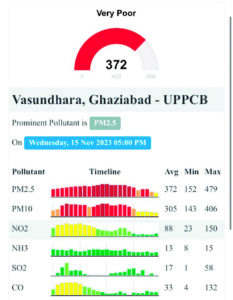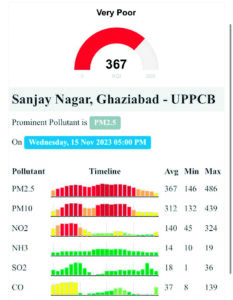
People faced difficulty in breathing and experienced burning and irritation in the eyes after the air quality dipped to the ‘very poor’ category in the Ghaziabad district on Wednesday.
As per the Central Pollution Control Board (CPCB), numerous areas of the district recorded bad air quality. It was recorded at 348 in the Sanjay Nagar area, 373 at Vasundhara, 376 in Indirapuram and 369 in the Loni area, all in the very poor zone.


Meanwhile, a thick layer of smog veiled the national capital on Wednesday morning and the air quality dropped in the ‘severe’ category in several parts of Delhi. Suresh Kumar, a morning walker told ANI, “The situation is worse. Earlier too, there used to be stubble burning and the bursting of firecrackers. The pollution is occurring mostly because of vehicles. Odd-even should be implemented always, as it makes a difference to an extent.”
While, Sikander Yadav, a resident of Munirka, said, “I go to clean vehicles in the morning. There is difficulty in breathing. The pollution was there before Diwali. The situation is worse.”
Meanwhile, the Delhi Fire Services (DFS) has resumed using water sprinklers in all 13 hot spots to curb the pollution in the city. The hotspots include Narela, Bawana, Mundka, Wazirpur, Rohini, RK Puram, Okhla, Jahangirpuri, Anand Vihar, Punjabi Bagh, Mayapuri, Dwarka. Three cities of Noida, Greater Noida and Ghaziabad continued to reel under “very poor” air quality even two days after Diwali on Tuesday, stated the CPCB’s daily air quality index (AQI) bulletin.
According to the AQI scale, readings between 0 and 50 are considered “good”, 51 and 100 are “satisfactory”, 101 and 200 are “moderate”, 201 and 300 are “poor”, 301 and 400 are “very poor”, 401 and 450 are “severe” and above 450 are “severe+”. The live air quality index reading, computed by the CPCB, showed that on Tuesday Ghaziabad’s Indirapuram recorded the highest AQI of 391, followed by Loni at 368, Vasundhara at 343, and Sanjay Nagar at 320, with PM2.5 being the main pollutant. Uttar Pradesh Pollution Control Board (UPPCB) officials said the department has resumed dust mitigation measures across the cities. Air pollution levels can be high during the winter months for a number of reasons, cold air is denser and moves slower than warm air, so it traps pollution and doesn’t whisk it away. This means that air pollution in the winter remains in place for much longer than during the summer.
According to doctors, for any healthy person, a recommended AQI should be less than 50, but these days the AQI has spiked beyond 400, which could prove fatal for those suffering from lung-related diseases and even pose a risk of lung cancer.

People faced difficulty in breathing and experienced burning and irritation in the eyes after the air quality dipped to the ‘very poor’ category in the Ghaziabad district on Wednesday.
As per the Central Pollution Control Board (CPCB), numerous areas of the district recorded bad air quality. It was recorded at 348 in the Sanjay Nagar area, 373 at Vasundhara, 376 in Indirapuram and 369 in the Loni area, all in the very poor zone.


Meanwhile, a thick layer of smog veiled the national capital on Wednesday morning and the air quality dropped in the ‘severe’ category in several parts of Delhi. Suresh Kumar, a morning walker told ANI, “The situation is worse. Earlier too, there used to be stubble burning and the bursting of firecrackers. The pollution is occurring mostly because of vehicles. Odd-even should be implemented always, as it makes a difference to an extent.”
While, Sikander Yadav, a resident of Munirka, said, “I go to clean vehicles in the morning. There is difficulty in breathing. The pollution was there before Diwali. The situation is worse.”
Meanwhile, the Delhi Fire Services (DFS) has resumed using water sprinklers in all 13 hot spots to curb the pollution in the city. The hotspots include Narela, Bawana, Mundka, Wazirpur, Rohini, RK Puram, Okhla, Jahangirpuri, Anand Vihar, Punjabi Bagh, Mayapuri, Dwarka. Three cities of Noida, Greater Noida and Ghaziabad continued to reel under “very poor” air quality even two days after Diwali on Tuesday, stated the CPCB’s daily air quality index (AQI) bulletin.
According to the AQI scale, readings between 0 and 50 are considered “good”, 51 and 100 are “satisfactory”, 101 and 200 are “moderate”, 201 and 300 are “poor”, 301 and 400 are “very poor”, 401 and 450 are “severe” and above 450 are “severe+”. The live air quality index reading, computed by the CPCB, showed that on Tuesday Ghaziabad’s Indirapuram recorded the highest AQI of 391, followed by Loni at 368, Vasundhara at 343, and Sanjay Nagar at 320, with PM2.5 being the main pollutant. Uttar Pradesh Pollution Control Board (UPPCB) officials said the department has resumed dust mitigation measures across the cities. Air pollution levels can be high during the winter months for a number of reasons, cold air is denser and moves slower than warm air, so it traps pollution and doesn’t whisk it away. This means that air pollution in the winter remains in place for much longer than during the summer.
According to doctors, for any healthy person, a recommended AQI should be less than 50, but these days the AQI has spiked beyond 400, which could prove fatal for those suffering from lung-related diseases and even pose a risk of lung cancer.

